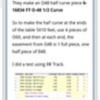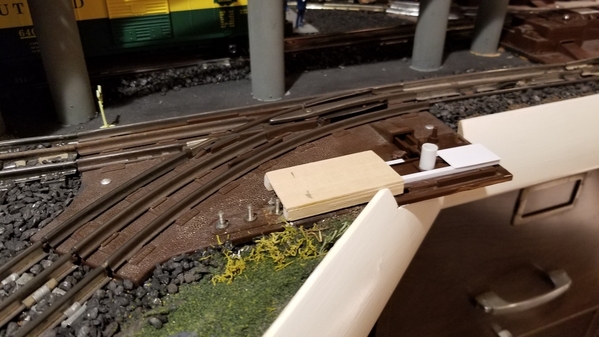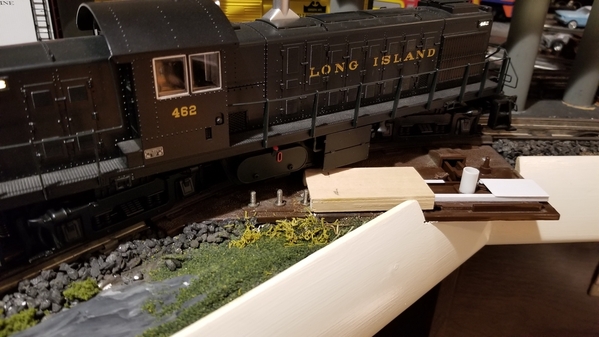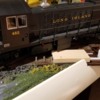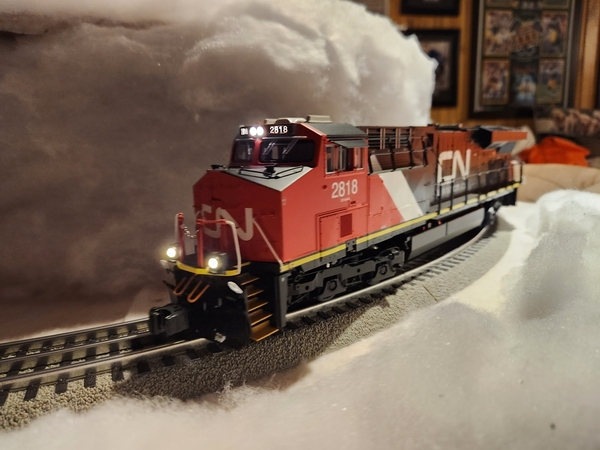I made a mistake and trying to figure out what to do. I bought the lionel sd 50 legacy engine. It says it requires 54 inch curve. I didn't catch that when I ordered from our local hobby shop. I won't stop the order as it would hurt the local shop. So I would like to figure how to make work. I know I have to change my layout but is a little under 5 foot wide and about 9 and half feet long. Increasing the size is not an option as it is our living room and my wife would kill me. I could make 48 inch work but not 60 and I guess they don't make 54 inch curves. I was wondering if I could use 48 and put in a short straight spacer to make it work. I don't want to have a beautiful engine like that just sitting on the shelf. Thanks in advance for any advice you share with me.
Replies sorted oldest to newest
Run it on a temporary 48" curve & see !
Well, if you "really" want to make it work, spend a little more money and buy O54 track made by another manufacturer. It should just barely fit on your table and you'll be able to run your engine "carefully." If you don't do this, you are probably buying a shelf queen.
Chuck
Makers of O54 curved track include: Atlas, Gargraves, Menards, MTH Realtrax, and Ross.
Is there a way to mate realtrax to fastrack?
Realtrax and FasTrack both offer adapter pieces to tubular.
@Ccriss posted:I found this article here and think this might do the trick. After this I will be more careful. I ordered the track to try this. Thanks for all your input.
Exactly what I was going to suggest. Easing into a curve with mixed radius sections usually works. I've found that most diesels will handle one radius size down from what they are rated for. Just make sure you check the clearances since it will overhang more on a tighter curve.
Bob
I agree with trestleking. I don't think most manufacturers test locos on O-48. If it says O-54 that may mean nothing more than it worked on O-54 but not on the next size down they tested. It may also mean that it was really pushing things to get it to go around an O-54 curve. Since most of us don't have access to Lionel insiders the only way to know which applies is to actually test the thing.
BTW don't rule out the LHS option just yet. Your LHS may have someone else who would love to get that loco but failed to order it. If so that would be a win-win-win scenario.
@Ccriss posted:I made a mistake and trying to figure out what to do. I bought the lionel sd 50 legacy engine. It says it requires 54 inch curve. I didn't catch that when I ordered from our local hobby shop. I won't stop the order as it would hurt the local shop. So I would like to figure how to make work. I know I have to change my layout but is a little under 5 foot wide and about 9 and half feet long. Increasing the size is not an option as it is our living room and my wife would kill me. I could make 48 inch work but not 60 and I guess they don't make 54 inch curves. I was wondering if I could use 48 and put in a short straight spacer to make it work. I don't want to have a beautiful engine like that just sitting on the shelf. Thanks in advance for any advice you share with me.
Very few engine require what is on the box. Most will go around a smaller radius than required, the rub will come in on switches and items close to a turn that is built in. Run the engine slow and see how it take the turns, look for obstructions alone the route.
@ThatGuy posted:Very few engine require what is on the box. Most will go around a smaller radius than required, the rub will come in on switches and items close to a turn that is built in. Run the engine slow and see how it take the turns, look for obstructions alone the route.
Case in point. I bought a MTH RS-1, rated for 031 curves. My layout is all 027 and since RS3's run fine I figured the same for a RS1.
Wrong...the fuel tank hits the switch motor covers. I had to convert a couple to manual so that I can run the engine on part of the layout.
Attachments
Charlie, you didn't post the product number. But if it's one of Lionel's newest offerings with the kinematic pilot, I sincerely doubt that you'll be able to pull a train reliably on anything smaller than O54.
For permanent layouts, I strongly prefer Ross and Atlas to Fastrack; redoing your layout would confer other benefits besides giving you an O54 option. However, I agree with the others who suggested that you work with the hobby shop to find another buyer for your order. Depending on your room dimensions, you could also ask your wife about widening the platform by 6" at either end to accommodate the larger curves.
Your post is just the latest example of something I've been saying for years... Scale trains aren't especially "housebroken," or family-friendly. Leopards are beautiful animals, but most of us couldn't have one for a pet! IMO, folks who don't have a large basement, attic, or bonus room to devote to our hobby are better off sticking with "traditional" O gauge. Hope you're able to get this situation resolved to your satisfaction.
Before you buy a shelf queen contact the dealer and explain your situation. Most dealers will gladly work with you. They may be able to offer an engine that meets your requirements.
It is lionel sd50 number 5503 I believe from the 2023 catalog. Also what is kinematic coupler?
I just looked up kinematic couplers. I see what you mean. Well I added 3.5 inches to my train board today to make it a total of 60 inches wide.I order last night what i think will work. I ordered the 060 curves plus the 048s to ease into the straight sections that looks to take me right to the edge of the train board. If this doesn't work I will add another three inches to my board and go all 060 curves. I might be sleeping in the dog house thou. I am not one usually to buy big engines normally. I like reproduction of the post war with the electronics. He is good one for you. My wife was the one who suggested I buy this 😆 🤣 😂.
@Ccriss posted:He is good one for you. My wife was the one who suggested I buy this 😆 🤣 😂.
![]()
![]() Now you have the excuse to make it a bit wider to accommodate the new engine. I hope the new engine provides you with many hours of enjoyment. Have fun!
Now you have the excuse to make it a bit wider to accommodate the new engine. I hope the new engine provides you with many hours of enjoyment. Have fun!
Charlie, here's a photo of a Lionel ES44AC on O48 Fastrack on my Christmas layout from a few years ago. Lionel also recommended O54 curves. As mentioned, most manufacturers don't make O48 track so O54 would be the closest. This should give you an idea of what your SD50 would look like on O48 track. Notice the pilot overhang. The O60 easement is a great idea.
Attachments
I have come to the conclusion that I am way out of my electric train social class with all these intricate changes in the engines and cars. Ted S is right. A lot of us old timers had to scale back our layouts as we move to smaller houses or apartments as we age out. Me being one of these folks. But I am happy to have at least a small layout to monkey with. My wife puts up with alot. She will do most anything to keep me off my motorcycle 🏍. She tries to keep me focused on trains 😆. It has been real enjoyable talking with all you folks. Thank you for sharing your fast knowledge. When get this all finished I will share some pictures of it. You all have a great Sunday.
@Ccriss posted:I just looked up kinematic couplers. I see what you mean. Well I added 3.5 inches to my train board today to make it a total of 60 inches wide.I order last night what i think will work. I ordered the 060 curves plus the 048s to ease into the straight sections that looks to take me right to the edge of the train board. If this doesn't work I will add another three inches to my board and go all 060 curves. I might be sleeping in the dog house thou. I am not one usually to buy big engines normally. I like reproduction of the post war with the electronics. He is good one for you. My wife was the one who suggested I buy this 😆 🤣 😂.
Just to let you know, The curve geometry of those two types of Fastrack is different. The O48 sections are 30 degrees and the O60 are 22.5 degrees.
@robmcc it looks like your ES44AC has kinematic pilots. Your photo proves that it runs on O48, but are there any issues pulling lightweight freight cars? I'm concerned that the centering springs on the pilot might be strong enough to armwrestle a trailing consist off the track.
Ccriss used the phrase "electric train social class." That's an interesting concept. For years postwar trains were "good enough" in terms of realism (though I always wished they would run more smoothly at slow speeds.) Enter the "scale revolution" of the 1990s. Now we have posts nit-picking paint colors, prototypical details, etc. The Legacy SD50 with its semi-fixed pilots is a great model. But how realistic to open the box and plop it down shiny new on O48 Fastrack? Are you prepared to weather it? Weather your rolling stock and buildings too? Super-detail your layout with realistic ground cover? Scale trains seem to call for a higher standard of modeling which many will never achieve. And for those of us in middle-age or later, we have to be realistic about what we're likely to accomplish in our remaining years.
Big locos demand wider curves which creates challenges with reach. So instead of a platform, you build an open ring of modules with a duck-under. Unfortunately, this architecture limits all but the largest spaces to a basic oval track plan which, for all of the effort and money spent, can get boring pretty quickly. ![]() Bigger locos demand scale-sized structures. Plasticville was undersized, but it looked "good enough" with undersized postwar trains. Being 30% smaller, you could squeeze a lot in which created a busy look that's hard to duplicate in 1:48.
Bigger locos demand scale-sized structures. Plasticville was undersized, but it looked "good enough" with undersized postwar trains. Being 30% smaller, you could squeeze a lot in which created a busy look that's hard to duplicate in 1:48.
Many of us aspire to a higher social class. Traditional O was a cohesive ecosystem that for many years gave this hobby a broad reach in terms of cost, physical space, and modeling skill. By comparison, the true promise of Scale will only be fulfilled by a determined few. After 10 years of buying exclusively Scale trains, I'm back in the Traditional camp and content to be here. There's no wrong way to enjoy this hobby. But as I consider future purchases, I believe that Charlie's concept of "electric train social class" is an eloquent way to frame the big picture. My $.02.
I've found Lionel to be fairly accurate when they say it needs a certain minimum curve radius, but MTH no so much. I ran into this same problem with curve spacing from the wall when I adjusted them for an MTH Big Boy, but then had to do it all over again when I got a Lionel Challenger whose swing over the curves at the cab where greater than the MTH BB. Like you, I am cramming as much operating I can get into a small space.
@Ted S posted:@robmcc it looks like your ES44AC has kinematic pilots. Your photo proves that it runs on O48, but are there any issues pulling lightweight freight cars? I'm concerned that the centering springs on the pilot might be strong enough to armwrestle a trailing consist off the track.
Ted, I haven't had any problems with derailments, string lining, etc. (so far...) I do tend to operate at lower, more prototypical speeds rather than doing my best Gomez Addams impression. So, that helps minimize any potential derailments. The main thing for consideration, I feel, is the overhang of the locomotive on the curve and making sure there's adequate clearance. I'm sure some would say it looks a bit awkward on a tighter curve, but most of us have to make do with the space available.
Rob





